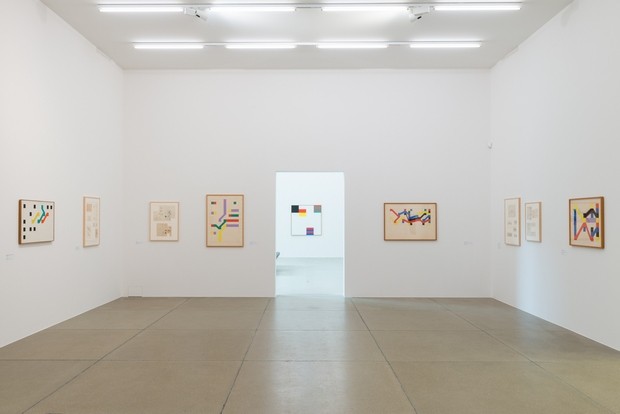Camille Graeser
and music
30 Jan - 10 Apr 2016

Camille Graeser und die Musik, exhibition view at Aargauer Kunsthaus, Aarau, 2016. Photo: Timo Ullmann, Aarau
Born in Geneva, Camille Graeser (1892 – 1980) is considered an important pioneer of post-war constructive-concrete art. The work he created as a member of the Zurich Concretists is central to the collection of the Aargauer Kunsthaus.
The exhibition Camille Graeser and Music focuses on Graeser’s “Loxodromic Compositions” which he created between 1947 and 1955. Consisting of some 70 paintings, drawings, and concept sketches, this group of works is illustrative of the artistic exploration of the rhythms and sound patterns of music. Geometric forms and bar constructions are combined into dynamic, rhythmic compositions. For this series of works the artist drew on various sources of inspiration, including the compositions of Johann Sebastian Bach (1685 – 1750) and Paul Hindemith (1895 – 1963) and Arnold Schönberg’s (1874–1951) concept of dodecaphonic music.
In his virtuoso handling of colour, form, and material Graeser also drew on his experience with a wide range of media as an interior architect, furniture designer, and commercial artist. In fact, he fully turned to art only in 1933 as a result of his emigration from Stuttgart to Zurich. As an exponent of concrete art he cultivated a stark formal language forgoing narrative content. Unlike his companions Max Bill and Richard Paul Lohse who both pursued a strictly theoretical approach, Graeser opted for a freer, more poetic practice. He himself described concrete art not just as “purity, law, and order” but also as “visibly formed pictorial sound.”
The exhibition Camille Graeser and Music focuses on Graeser’s “Loxodromic Compositions” which he created between 1947 and 1955. Consisting of some 70 paintings, drawings, and concept sketches, this group of works is illustrative of the artistic exploration of the rhythms and sound patterns of music. Geometric forms and bar constructions are combined into dynamic, rhythmic compositions. For this series of works the artist drew on various sources of inspiration, including the compositions of Johann Sebastian Bach (1685 – 1750) and Paul Hindemith (1895 – 1963) and Arnold Schönberg’s (1874–1951) concept of dodecaphonic music.
In his virtuoso handling of colour, form, and material Graeser also drew on his experience with a wide range of media as an interior architect, furniture designer, and commercial artist. In fact, he fully turned to art only in 1933 as a result of his emigration from Stuttgart to Zurich. As an exponent of concrete art he cultivated a stark formal language forgoing narrative content. Unlike his companions Max Bill and Richard Paul Lohse who both pursued a strictly theoretical approach, Graeser opted for a freer, more poetic practice. He himself described concrete art not just as “purity, law, and order” but also as “visibly formed pictorial sound.”
